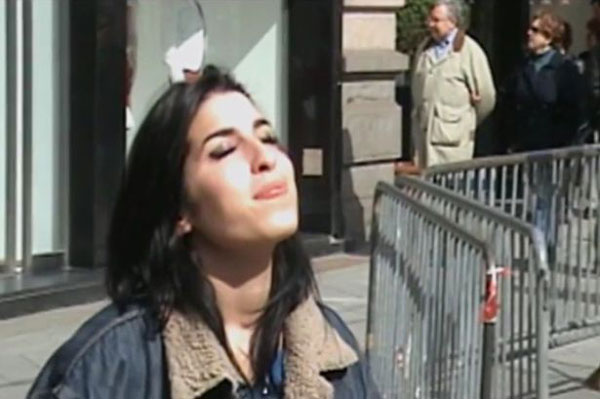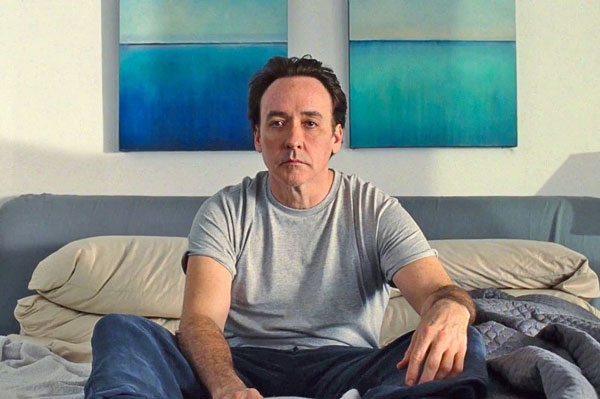By the time of her death in July 2011, Amy Winehouse had become an object of public scorn. She was a punchline for late-night comics—even those, such as Jay Leno, who had had her as a guest on their shows--and a cautionary tale about the excesses of the rock-and-roll lifestyle. There was even a website that took bets on the exact day she would die.
Amy, Asif Kapadia’s new documentary, demonstrates how unfair that perception was, and what a great artist we lost in her. We can say that her death by alcohol poisoning at 27 was the plain and simple truth, but we can also remember Oscar Wilde’s observation that the truth is rarely plain and never simple. Kapadia
and film editor Chris King had access to an astonishing wealth of film and videotape, and they use it to tell a life story that was triumphant, chaotic and tragic by turns. The first scene is a grainy home movie of a 14-year-old Amy singing “Happy Birthday” to her friend Lauren Gilbert; the voice—rich, smoky, passionate, with beautiful intonation—is already there.
Watching the performance footage in Amy, viewers can have no doubt that Winehouse was the most gifted singer of her generation. There is so much footage of Amy singing, and all of it is so thrilling, that it is astonishing to realize she released only two CDs. Unfortunately, the rest of the movie makes it evident why she recorded so little. Bold and confident in her art, Winehouse was shy and vulnerable in her life, as is so often the case with gifted performers.
A jazz singer by talent and inclination, Winehouse idolized performers such as Dinah Washington, Sarah Vaughan, and her all-time favorite Tony Bennett. (Watching a Grammys broadcast from a London club, Winehouse was more thrilled at Bennett saying her name than she was at winning the award.) She would have been perfectly happy singing in small clubs throughout her career; worldwide fame, with the attendant paparazzi and tabloid trashmongers slavering over every detail of her life,
was something she wasn’t prepared for. The booze, drugs, and bulimia were symptoms of her problems, not the cause.  |
Most of Amy Winehouse’s life was a scream for emotional support. She received it from some people: her friends Lauren Gilbert and Juliette Ashby, her longtime manager Nick Shymansky, fellow performers such as rapper Yasiin Bey. But at least according to the film, the most important people in her life not only let her down, but knocked her down and kicked her in the face. (It is not surprising that Winehouse’s family has
disowned Kapadia’s film.) Her mother Janis comes across in the film as ineffectual. Her father Mitch deserted the family when Amy was small, only to come back when she became rich and famous. Throughout the film, Mitch is explicitly more concerned about Amy going on tour and making money than about her obtaining treatment for her addictions. When Amy escaped to rehab on the Caribbean island of St. Lucia—a place she
loved—Mitch followed with a camera crew, without Amy’s knowledge or permission, to film a reality show. Blake Fielder-Civil, Winehouse’s on-again, off-again husband, appears to have been an even worse influence than Mitch. Both emotionally and morally unreliable, Blake introduced Amy to the joys of heroin and cocaine. Later, when they entered rehab
together, it was Blake who initiated it, but it was Amy who was really committed to getting clean. Unfortunately, once drugs were out of her life, she filled the gap with alcohol. Though overlong at 128 minutes, Amy is a thrilling cinematic experience, though so mournful that few people could bear to see it more than once. The scenes of Winehouse being chased
down the street by mobs of clicking cameras are both saddening and enraging. There is a respite toward the end, when Winehouse records a duet with her idol, Tony Bennett. Winehouse is nervous and self-doubting; Bennett is kind and patient in response. The scene between Winehouse and Bennett is a heartbreaking glimpse of the career, and life, that Winehouse could have had.
One month later was the concert in Belgrade, at which Winehouse tottered across the stage, too drunk to sing, and the crowd howled insults at her. One month after that, she was dead. The summing-up is left to Bennett: “Life teaches you how to live it, if you live long enough.” Amy Winehouse wasn’t lucky
enough to find this out for herself, but Brian Wilson was. Wilson was beset by most of the same addictions as Winehouse. Added to that was mental illness so severe that for two years he couldn’t leave his bed. Love & Mercy, Bill Pohlad’s new film, isn’t the story of Wilson’s addictions. It is something far more complex, and far better. Co-produced by Wilson,Love & Mercy intercuts two crucial times in Wilson’s life. In the first, set in the mid-1960s, Wilson (Paul Dano) is creating his greatest album, Pet Sounds. The second, set about 25 years later, depicts the middle-aged Wilson (John Cusack), a laconic, ravaged husk of a man, trying to rebuild his life and career while under the control of a psychiatrist-cum-Svengali, Eugene Landy (Paul Giamatti). It’s
one of the oldest clichés in movies to say that Wilson was saved by the love of a good woman, but that’s exactly what happened to him, in the person of Cadillac saleswoman Melinda Ledbetter (Elizabeth Banks).  |
Some critics have praised the first story while panning the second, which I think is unfair. However, there’s no denying the visceral excitement Pohlad evokes in the first section, showing a genius at work. Few films of its kind have been so effective at this. Dano, at 31 already a certifiably great actor, is brilliant at
portraying Wilson’s obsessive quest for exactly the right sound, deploying unusual instruments, specially tuned pianos and even the howling of his dogs. Unfortunately, geniuses aren’t always appreciated, even (sometimes especially) by those closest to them. Fellow Beach Boy Mike Love (Jake Abel) is openly scornful of Pet Sounds. “Even the happy songs are sad!” he complains. Yet even Love’s
nay-saying is nothing compared with the predations of Wilson’s father Murry (Bill Camp), an abusive drunk who regards Brian as his personal ATM. Meanwhile, Wilson’s deeper problems are beginning to surface. In one particularly harrowing sequence, the sounds of an ordinary dinner party drive Wilson into a shrieking panic. Before long, a bed, a bottle of booze and a bottle of pills are the only
things he can handle. In the second story, Wilson and Melinda meet in Melinda’s showroom, in the front seat of a Cadillac Wilson wants to buy. At first Melinda doesn’t know who her customer is, or precisely what to make of this Alice in Wonderland creature, but she finds him charming.
Then Landy bursts into the showroom, and brings Wilson to heel (that’s the exact phrase). But Wilson, despite Landy’s edicts otherwise, is set on seeing Melinda again. The growing love between Wilson and Melinda, and the growing determination of Landy to put a stop to it, forms the crux of the second story, eventually becoming a war between Melinda and Landy for Wilson’s soul.
Cusack, Banks, and Giamatti all shine. Giamatti projects just the right combination of smarminess and arrogance as Landy, a Uriah Heep for the rock era. Banks radiates kindness and common sense as Melinda. Cusack’s achievement is more elusive; some critics have been less than kind to him, but I found his performance the best of the three. A man living on brittle nerve-ends after decades of emotional upheaval, Cusack’s
Wilson has a shattered dignity that at times is almost unbearably poignant. Wait for the scene in which Landy bullies Wilson at a patio barbecue; your heart will ache. The screenplay by Oren Moverman and Michael Alan Lerner provides Pohlad with the flexible structure he needs to glide gracefully between the episodes of Wilson’s life. Pohlad’s crew is excellent, including cinematographer Robert D. Yeoman, editor Dino Jonsater and production designer Keith P. Cunningham. The sequences set in the 1960s are especially impressive visually. Love & Mercy ends triumphantly. We see pictures of the wedding of the real-life Wilson and Melinda, and concert footage of Wilson singing one of the songs from Smile,the album he completed (and won his first Grammy for) nearly forty years after abandoning it. The most recent interviews Wilson show a man who, though something of a physical wreck, is finally at
peace with himself. Of Amy Winehouse, alas, we can only say that she is at peace. |